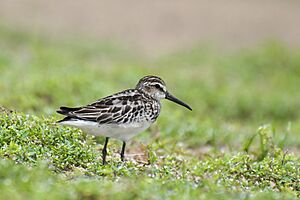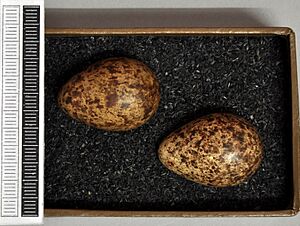Broad-billed sandpiper facts for kids
Quick facts for kids Broad-billed sandpiper |
|
|---|---|
 |
|
| Conservation status | |
| Scientific classification | |
| Genus: |
Calidris
|
| Species: |
falcinellus
|
| Synonyms | |
|
Limicola falcinellus |
|
The Broad-billed Sandpiper (scientific name: Calidris falcinellus) is a small wading bird. Its scientific name comes from Latin. The word falcinella means "a sickle", which might refer to its bill shape. Some scientists think this bird could belong to a different group of birds called Philomachus.
Contents
What Does It Look Like?
Broad-billed Sandpipers are small wading birds. They are a bit smaller than a dunlin, but they have a longer, straighter bill. Their legs are also shorter.
Colors and Patterns
When these birds are breeding, their upper parts are dark gray with cool patterns. Their bellies are white. They also have blackish marks on their chest. You can spot a pale stripe on their head and above their eyes.
In winter, they look lighter. Their upper parts turn pale gray, and their undersides are white. They still keep their unique head pattern. Young birds have backs similar to young dunlins. However, their white sides and belly, along with a brown-streaked chest, help you tell them apart.
Sounds They Make
When Broad-billed Sandpipers call out, it sounds like a dry, whistling "dree-it, dree-it." They also make a clicking "dik dik" sound.
Where Do They Live and Travel?
The Broad-billed Sandpiper is a migratory bird. This means it travels very long distances. They spend their non-breeding season in places like eastern Africa, southern and southeastern Asia, and even Australasia.
Traveling Together
These birds love to be in groups. They often fly in flocks with other wading birds, especially dunlins. Even though they breed in Europe, you don't often see them in western Europe. This is probably because they take a migration route that goes more towards the southeast.
Breeding Spots
These sandpipers breed in wet taiga bogs. These are marshy, forested areas in the Arctic parts of northern Europe and Siberia. During courtship, the male bird performs a special aerial display in the sky. They make their nests on the ground. Each nest usually holds four eggs.
What They Eat
Broad-billed Sandpipers look for food in soft mud. They search in marshes and along the coast. They mostly pick up food by sight. Their diet mainly includes insects and other small creatures without backbones.
This bird is part of an important agreement. It's called the Agreement on the Conservation of African-Eurasian Migratory Waterbirds (AEWA). This agreement helps protect migratory waterbirds.




